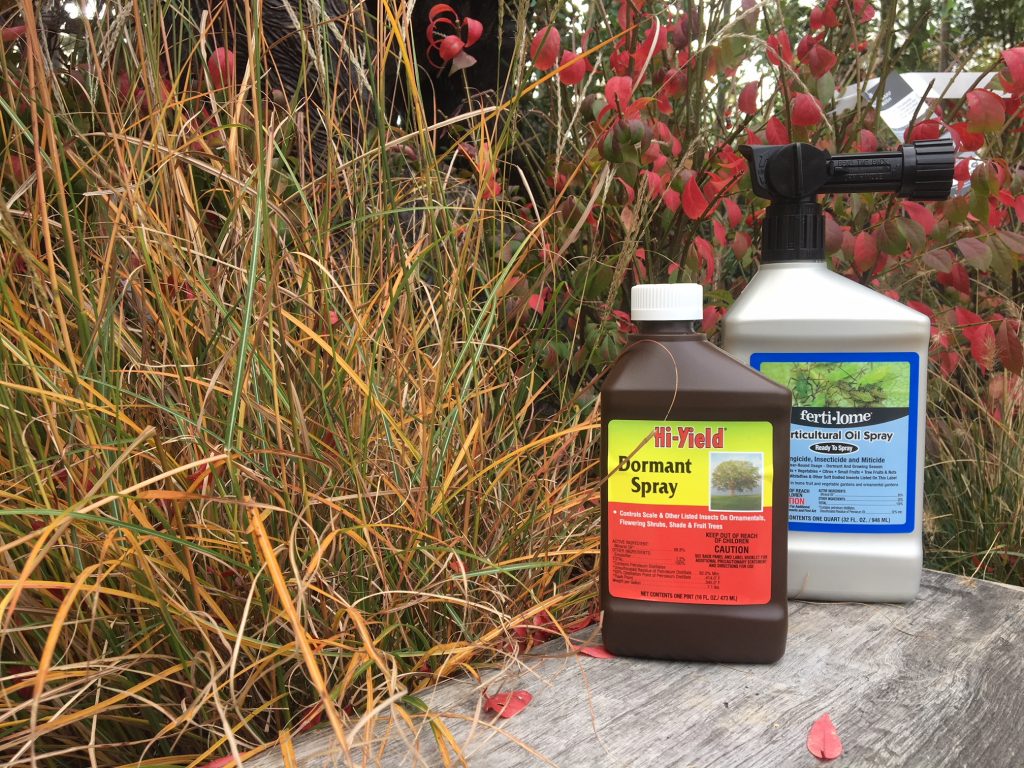How to Effectively Use Dormant Oil
What is dormant oil?
Dormant oil refers more to when the oil has traditionally been applied rather than what it is made of. Newer dormant oil formulations are typically refined from petroleum oil, such as mineral oil. Unlike home remedies, they also contain an emulsifier to help water mix with the oil, which will provide more complete coverage of plant surfaces. Dormant oil may also be labeled as horticultural, superior or all-seasons oil; keep reading for more on this.
How does dormant oil work?
Dormant oils were first utilized to control insect pests on fruit trees, where an effective control that wasn’t harmful to pollinators and was safe for ingestion by humans was needed. The oil covers leaf and limb surfaces, suffocating insects and some insect eggs, which reduces harmful insect populations. It may also interfere with insect feeding. Dormant oils don’t leave a toxic residue and dissipate quickly, making them ideal for use on blooming plants that will have pollinators arrive later during the growing season. It is also considered safe to use around humans and pets.
What pests does dormant oil control?
Dormant oil sprays can control a variety of insect pests such as aphids, mealybug, thrips, whiteflies, adelgids, caterpillar eggs, leafhoppers, scale and mites. This control is more effective on young insects and less effective on more mature insects so timing and early intervention is key. With the destructive, newly discovered Crape Myrtle Bark Scale wreaking havoc in Little Rock, applying Dormant Oil is a crucial step in saving crape myrtles. Read our blog post for additional control methods for CMBS. Dormant oil can also help control powdery mildew, a common foliar disease. Because dormant oil can be an effective aphid control, and aphids vector and spread viruses, it could be said that it also helps reduce plant viruses.
When should dormant oil be applied?
Although more traditional dormant oils should only be applied when a plant is dormant, newer formulations can be sprayed at alternate times of the year at a lower application rate. Because some new formulations may be used when the plants are not dormant, be aware that they may be called superior oils, horticultural oils or all-season oils. Since recommended application rates and temperature ranges differ between dormant oils, it’s imperative to read each product’s label and follow directions carefully. Failing to do so could result in plant leaves burning or essentially suffocating a plant. A good rule of thumb is to avoid spraying on sunny days (even during cooler weather) and avoid spraying when temperatures are freezing or close to freezing. The emulsifiers aren’t effective in low temperatures and coverage will be uneven. Also, avoid applying when severe freezing trends are expected within the following 3 to 4 days. Apply in early morning or late afternoon, and avoid spraying on days that temperatures above 90 degrees are expected. The ideal temperature range for application is between 40 and 70 degrees, with the day of application expected to stay above 50 for at least 24 hours. Drought stressed plants are more susceptible to oil damage; do not spray on drought stressed plants. Conversely, applying during very humid conditions reduces the rate of evaporation and can also cause burning. Apply when rain is not predicted for the next 24 hours. Do not apply if a sulfur based pest control product has been applied within the previous 30 days as the oil and sulfur combination can be toxic to plants. Fruit trees should only be treated with dormant oil when dormant; which is prior to bud swell. Applications may be repeated on fruit trees in 3 to 4 week intervals.
How should dormant oil be applied?
Spray with hose end sprayer (better for larger plants as the spray will go further) or pump sprayer, making sure to cover entire surface of branches, trunk and underside of leaves. Thoroughly rinse container and spray ends of both type of sprayer with water after use. This is needed to remove any clogs that could form if the oil solidifies after use. There are plants that are sensitive to oil applications; a list can usually be found on the product label. Applying to houseplants may cause injury; treat small portions of plants to test before treating entire plants. Read directions carefully; including safety instructions.
